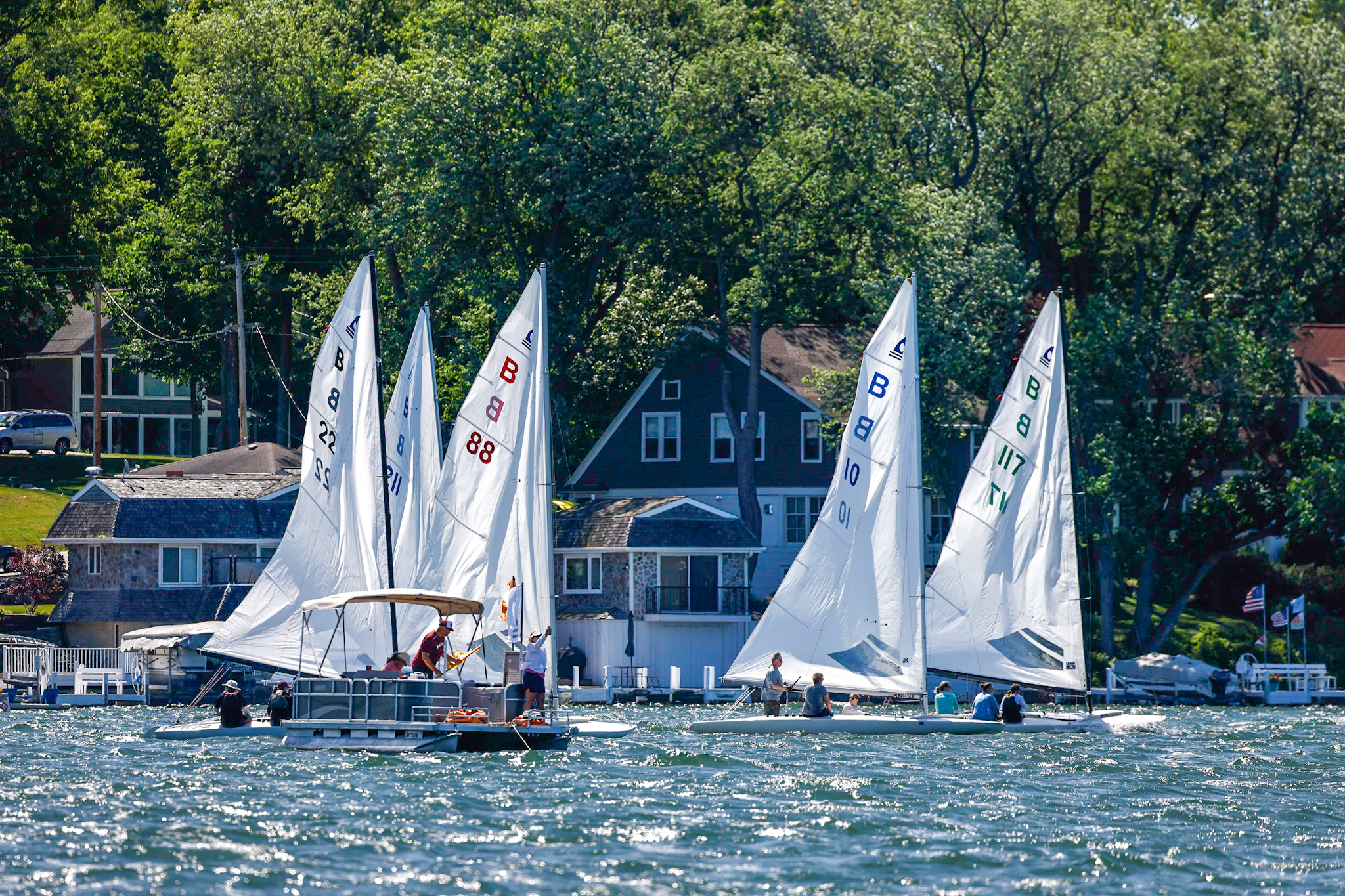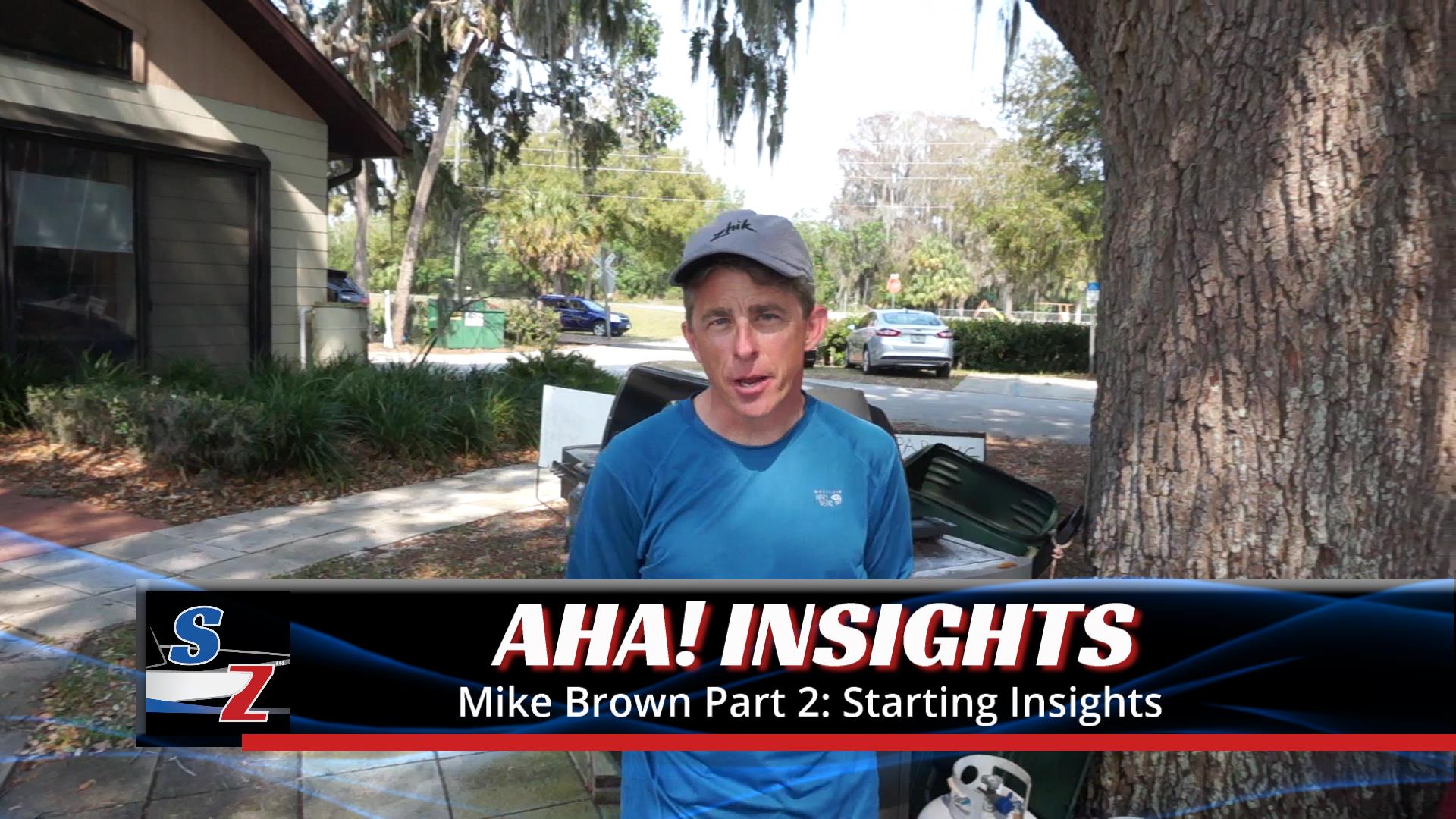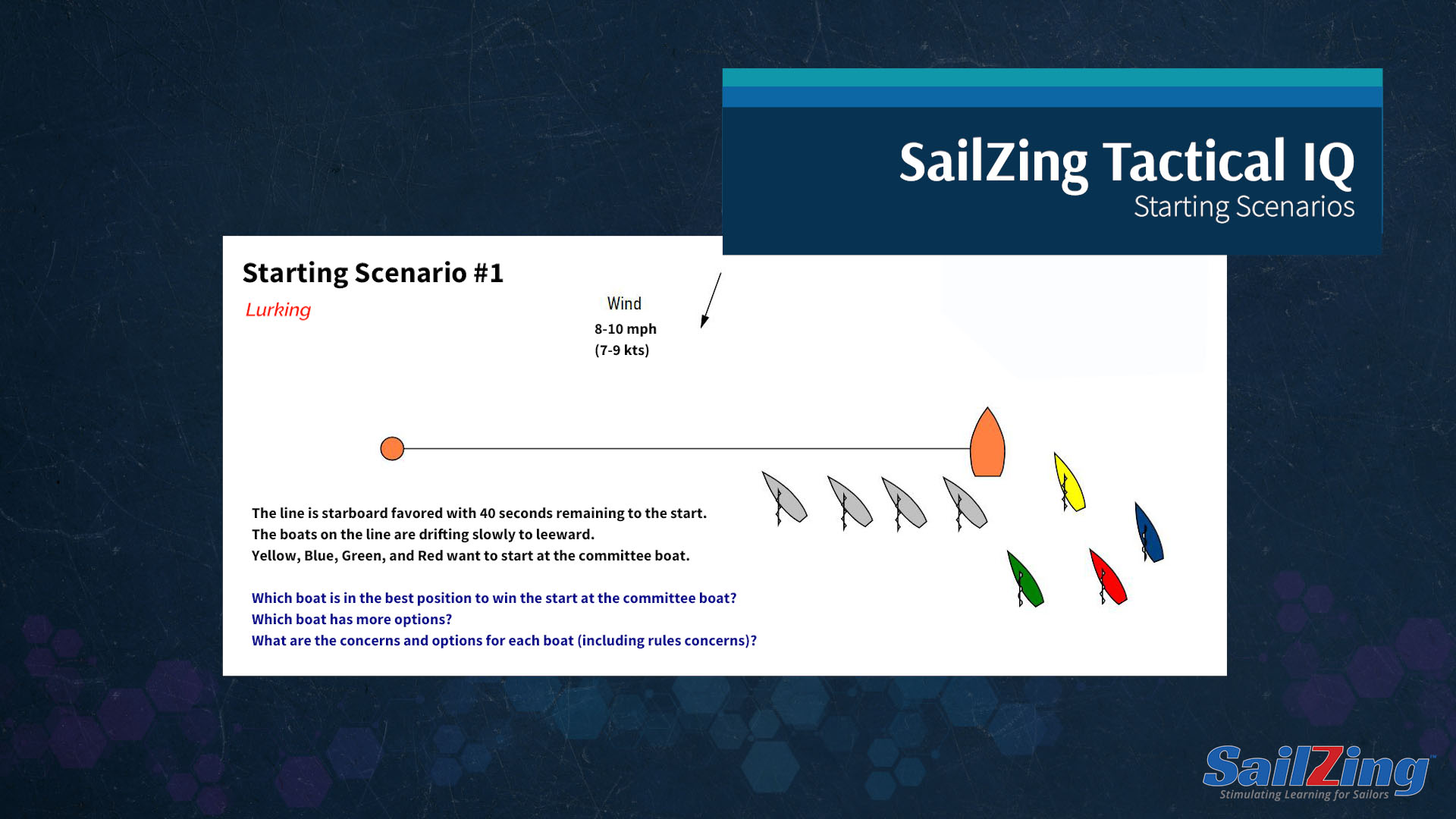In this series of articles, we will introduce the key concepts of sailing a race from preparation to the starting sequence, buoy roundings and finishing. The target audience for this information is sailors that may have never competed in a formal race environment or want to better understand what is going on during a race. The target could also include someone who spectates and wants to better comprehend what is happening. Throughout, we will link to more advanced information, but the body of the article will be the basics. We will not go into rules details, but will mention rule areas that pertain to various situations, for further study. If we missed a basic concept, feel free to comment below. There will be links to lots of articles at the end.
We’ll begin with Pre-race Preparation to Starting.
On Shore
Weather Forecast and Current Conditions
- Wind Direction
- Wind shifting through the racing period? Persistent (shifting one direction further and further) or Oscillating shifts (shifts back and forth, but generally around the same average direction). For example, if there is a Persistent Shift moving clockwise, the starboard tacks will get increasingly favored, assuming that the marks are not moved.
- Wind Velocity
- Will the wind speed be increasing? If so, you may need to adjust your boat and sail controls for the changing conditions.
- Storms – Is there a storm system moving through that might bring changes to the winds?
Preparation Checklist – Equipment
We suggest a checklist to remind you of things to look over and things to ensure that you have for the race. These might include the following:
- Fittings – Are they secure and all present? Do you have spares?
- Control Lines & Blocks – Are your lines (ropes) all in good shape, untangled and running through the blocks (pulleys) in the correct directions for any ratcheting?
- Spars – Are your lines clear of your shrouds (sidestays) for when you hoist your sail(s)? Have you adjusted your mast “rake” (tilt)? Does your boat require setting “rig tension”? Are your shroud fittings connected securely? Are your shrouds / stays in good condition without any broken strands / wires?
- Blades – Centerboard / Daggerboard, Rudder: Are these clean and moving smoothly? Do you have the safety line attached to the daggerboard, if appropriate.
- Sails – Are your sails all on board and connected properly? Make sure that nothing gets in the way of hoisting them and battens are all in place and secure. If you have sail ties, are they properly tied and knots tight? Are the “Outhaul” and “Cunningham (Downhaul)” attached?
- Personal Flotation Device (PFD) Safety Gear – Do you have approved PFDs for all crew?
- Racing Timer – Do you have your timer and is it set to the proper timing sequence? Usually 5 or 6 minutes, but will vary somewhat.
- Water – Do you have water to stay hydrated?
- Suntan lotion & Sunglasses – Is your skin protected? The water reflects the sun and can make burning more likely. Same issue with sunglasses. I prefer polarized lenses to reduce the glare off the water and the boat surfaces.
- Hat – While protecting your head, a hat can also reduce distracting sun glare when trying to see the water.
- Sailing Gloves – Purpose-built sailing gloves (properly-fitted) or gardening gloves can really protect your hands from abrasion and helps to hang on to the sheet lines.
Venue
- Launching – Are your bailers up? If launching with a trailer, is the lighting harness disconnected from the towing vehicle to prevent electrical shorts? Do you know where you will put the boat to finish assembling it while allowing others to launch?
- Current – Is there water flow / current that may impact your sailing? Which way is it moving and how fast? A tip is to look at any fixed buoys and see how the water is moving around them.
- Shoals / Weeds – Do you know where shallow areas and weedy areas are?
- Wind Obstacles – Look for hills, trees, peninsulas, tall buildings, etc that may reduce or bend the wind direction and think about how that will impact your sailing.
- Local Insights – Have you checked with local sailors for any insights they may have about the venue?
On the Water
Before The Sequence
Be Early – Try to get to the racing area no less than 30 minutes ahead of time so that you can get familiar with what is going on and form a “strategy” for how you want to sail the course.
A Strategy is the path you would sail with no other boats on the race course. Tactics are what you do when you encounter other boats to get back on your strategy. – Dave Dellenbaugh
Survey the Course – Sail both sides of the course and the top mark rounding and the starting line area to learn about the tacking angles and wind pressure (force) across the course. Take note of where the wind seems to originate, if there is any current and are the shifts happening the way that you predicted from the forecast.
Learn From Others – Watch how the other competitors are sailing, who is lifted (sailing straighter to the marks) and who is knocked and who has better wind pressure, where.
Benchmark Against Others – Try to get somewhat near another competitor and see how well your boat is performing versus the other boat. Are you pointing higher or lower while watching your sail telltales to make sure that your sail and point (how close to the wind direction you aim) is correct? Can you match or exceed their speed in similar breeze? Try adjusting controls if you need to to test things out.
Check-In – Check-in with the Race Committee to let them know that you’re sailing, if necessary. Home port fleet races may not require this.
Ready To Start
Anatomy of The Line
Typically, the starting line is between an anchored Race Committee boat with an orange flag on the starboard end and a mark (buoy) on the port end. The line is usually roughly perpendicular to the windward marks.
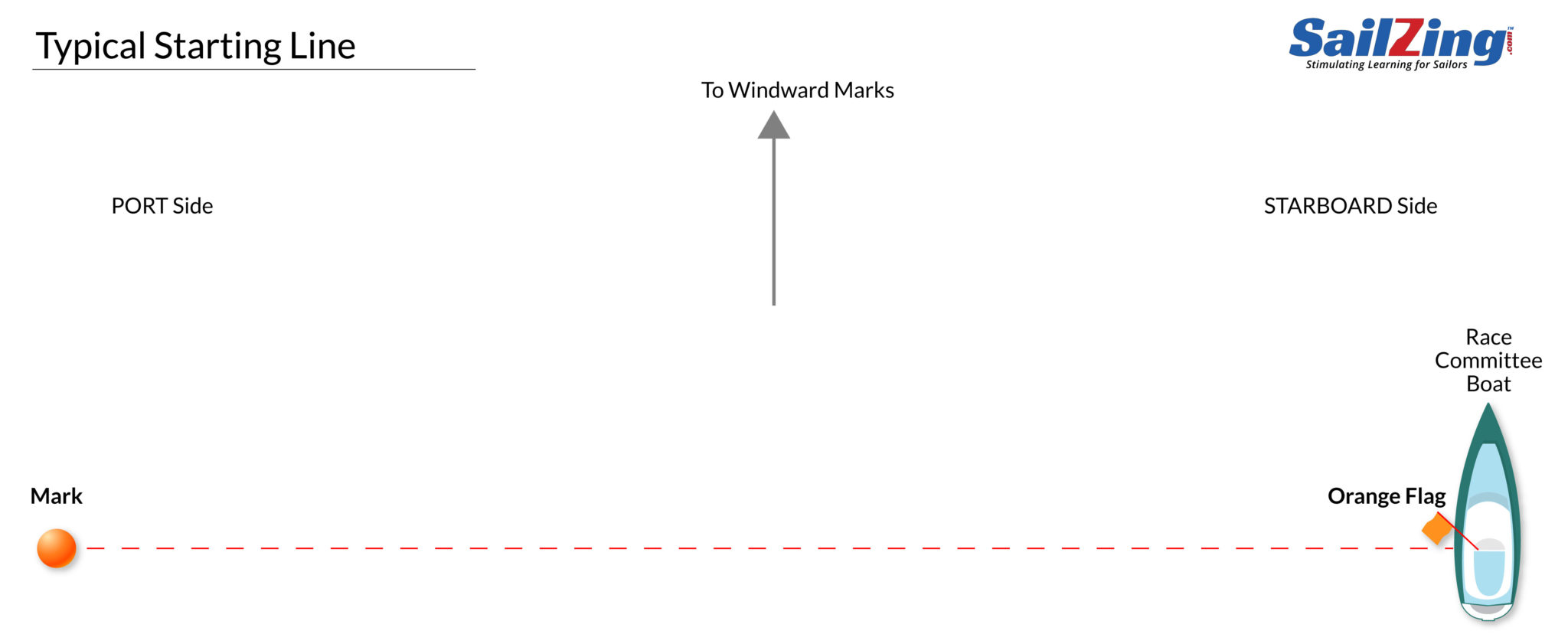
Getting Ready
So you’ve sailed around the race area and have a preliminary strategy. What should you be thinking about now?
- “Favored End”
- RC Boat End might be favored if:
- Wind angle has shifted right of center (looking up the race course).
- Wind is centered, but the breeze is stronger on the RC Boat end.
- Mark (or “Pin) End might be favored if:
- Wind angle has shifted left of center.
- Wind is centered, but the breeze is stronger on the Pin end.
- The Mob: If a lot of boats want your spot, then it might be best to stay beside the pack, but on the starting line, and not stuck inside pack. You want clear air and ability to accelerate off the line.
- Line Length – A rule of thumb is that the line length should be 1.5 boat lengths X # of boats competing. If it’s less than that, be ready for it to be a tight start.
- RC Boat End might be favored if:
- Strategy Update
- Wind Angle Change? Watch competitors who are still sailing upwind and down to see what their angles are.
- Wind Pressure obviously better on one part of the leg? Again, watch competitors to see who is in the breeze.
- Wind Shifts – Are the shifts Persistent (more and more in one direction) or Oscillating (back and forth, but generally on either side of a similar direction)?
- Equipment and Crew Ready for action – Is everything untangled and gear is on correctly so that there is no last minute problem?
In The Sequence
This graphic show the timing sequence and flag signals and what they mean. The Preparatory Signal flag(s) are important because they tell you what is permitted during this start and what the penalties will be. Some penalties can be remedied and some disallow you to sail in the race.
Note the Racing Triangle diagram. The Racing Triangle is the area between each end of the line and the windward mark.
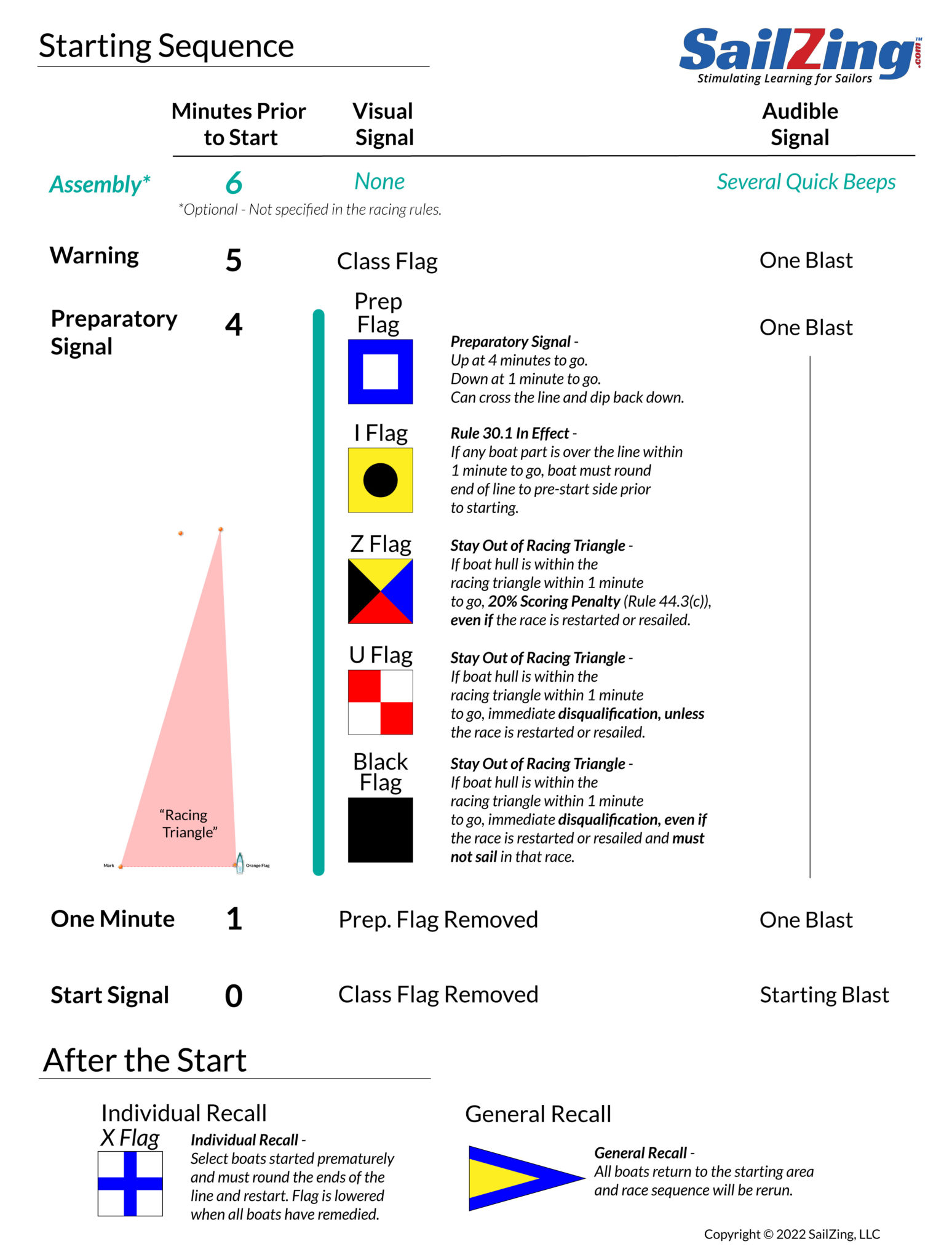
Ready, Set, Go!
- Timing to Get Your Spot – Know where you want to start on the line and position yourself to be there ahead of time, at least with enough time to hit the line at full speed at the gun.
- Make and Defend a “Hole” – For best results, you want space to leeward of your boat on the line so that you can bear off (point down) to accelerate before crossing the line. This is usually hard against good sailors and takes practice.
- What’s Your 0-60? – Know how long it takes for your boat to accelerate from a stop in different breezes. This will help you to know when to “pull the trigger” on accelerating during the countdown sequence. Drill: Stop next to a buoy (not during a race) and see how long it takes to get to full speed and review your distance from the buoy location.
- Prepare to be fast and smooth – lines clear, controls set, ready to hike, know who is around you and what they’re doing.
- Wind Shifts While Starting – See this article.
- Oops – When things go wrong
- Penalty Strategies
- Note the penalties for being over the line early and avoid them or know what your rights are if you mess up.
- Fouling Someone – Be ready to figure out how to save yourself if you have to take a penalty turn.
- Bail Out – If you get jammed in a spot, know whether the best option is to just stay in the bad spot or if tacking off will improve your situation. Many times tacking off will result in ducking boat after boat or being forced back, so assess the options quickly.
- Penalty Strategies
Further Learning: Starting well takes practice and has a lot of aspects. There are a number of links below that can help you to dig deeper into this topic.
Related Content
SailZing Category: Starting Strategy and Tactics Category
Individual articles:
Starting Strategy and Tactics: Where to Start – SailZing
Starting Mentality: Learn to Be Aggressive – SailZing
Starting Line Approach: What Kind of Creature Should You Be …
Wind Shifts While Starting: Impacts and Tips – SailZing
Starting Tactics Quiz: Boat Thoughts at 30 Seconds – SailZing
Bad Start? Four Recovery Options
Line Sag: Illusions and Opportunities

